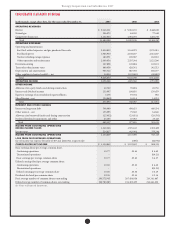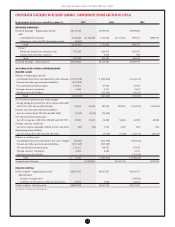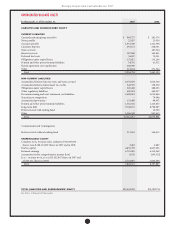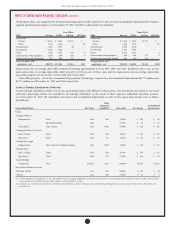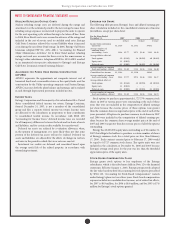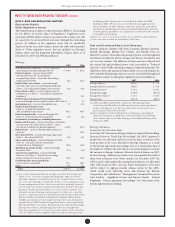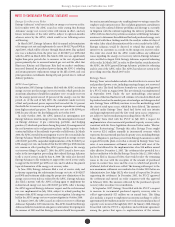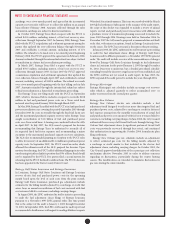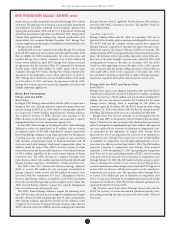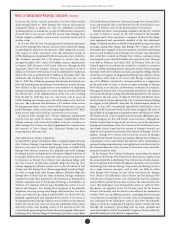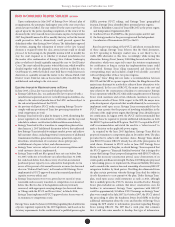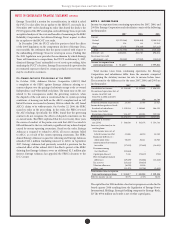Entergy 2007 Annual Report Download - page 66
Download and view the complete annual report
Please find page 66 of the 2007 Entergy annual report below. You can navigate through the pages in the report by either clicking on the pages listed below, or by using the keyword search tool below to find specific information within the annual report.
64
Entergy Corporation and Subsidiaries 2007
Notes to Consolidated Financial Statements continued
hedged. Gains or losses accumulated in other comprehensive income
are reclassied as earnings in the periods in which earnings are aected
by the variability of the cash ows of the hedged item. e ineective
portions of all hedges are recognized in current-period earnings.
Entergy has determined that contracts to purchase uranium do not
meet the denition of a derivative under SFAS 133 because they do not
provide for net settlement and the uranium markets are not suciently
liquid to conclude that forward contracts are readily convertible to
cash. If the uranium markets do become suciently liquid in the
future and Entergy begins to account for uranium purchase contracts
as derivative instruments, the fair value of these contracts would be
accounted for consistent with Entergy’s other derivative instruments.
FA I R V A L U E S
e estimated fair values of Entergy’s nancial instruments and
derivatives are determined using bid prices and market quotes.
Considerable judgment is required in developing the estimates of fair
value. erefore, estimates are not necessarily indicative of the amounts
that Entergy could realize in a current market exchange. Gains or
losses realized on nancial instruments held by regulated businesses
may be reected in future rates and therefore do not accrue to the
benet or detriment of stockholders. Entergy considers the carrying
amounts of most nancial instruments classied as current assets and
liabilities to be a reasonable estimate of their fair value because of the
short maturity of these instruments.
IM P A I R M E N T O F LONG-LI V E D AS S E T S
Entergy periodically reviews long-lived assets held in all of its business
segments whenever events or changes in circumstances indicate that
recoverability of these assets is uncertain. Generally, the determination
of recoverability is based on the undiscounted net cash ows expected
to result from such operations and assets. Projected net cash ows
depend on the future operating costs associated with the assets, the
eciency and availability of the assets and generating units, and the
future market and price for energy over the remaining life of the assets.
See Note 13 to the nancial statements for a discussion of the asset
impairment recognized by Entergy in 2005.
RI V E R BE N D AFUDC
e River Bend AFUDC gross-up is a regulatory asset that represents
the incremental dierence imputed by the LPSC between the AFUDC
actually recorded by Entergy Gulf States Louisiana on a net-of-tax
basis during the construction of River Bend and what the AFUDC
would have been on a pre-tax basis. e imputed amount was only
calculated on that portion of River Bend that the LPSC allowed in rate
base and is being amortized through August 2025.
RE A C Q U I R E D DE B T
e premiums and costs associated with reacquired debt of
Entergy’s Utility operating companies and System Energy (except
that portion allocable to the deregulated operations of Entergy Gulf
States Louisiana) are included in regulatory assets and are being
amortized over the life of the related new issuances, in accordance
with ratemaking treatment.
TA X E S IM P O S E D O N RE V E N U E -PR O D U C I N G T R A N S A C T I O N S
Governmental authorities assess taxes that are both imposed on and
concurrent with a specic revenue-producing transaction between a
seller and a customer, including, but not limited to, sales, use, value
added, and some excise taxes. Entergy presents these taxes on a net
basis, excluding them from revenues, unless required to report them
dierently by a regulatory authority.
NE W AC C O U N T I N G PR O N O U N C E M E N T S
In September 2006 the FASB issued Statement of Financial Accounting
Standards No. 157, “Fair Value Measurements” (SFAS 157), which
denes fair value, establishes a framework for measuring fair value
in GAAP, and expands disclosures about fair value measurements.
SFAS 157 generally does not require any new fair value measurements.
However, in some cases, the application of SFAS 157 in the future may
change Entergy’s practice for measuring and disclosing fair values
under other accounting pronouncements that require or permit fair
value measurements. SFAS 157 is eective for Entergy in the rst
quarter 2008 and will be applied prospectively. Entergy does not expect
the application of SFAS 157 to materially aect its nancial position,
results of operations, or cash ows.
e FASB issued Statement of Financial Accounting Standards
No. 159, “e Fair Value Option for Financial Assets and Financial
Liabilities” (SFAS 159) during the rst quarter 2007. SFAS 159 provides
an option for companies to select certain nancial assets and liabilities
to be accounted for at fair value with changes in the fair value of those
assets or liabilities being reported through earnings. e intent of the
standard is to mitigate volatility in reported earnings caused by the
application of the more complicated fair value hedging accounting
rules. Under SFAS 159, companies can select existing assets or liabilities
for this fair value option concurrent with the eective date of January 1,
2008 for companies with scal years ending December 31 or can select
future assets or liabilities as they are acquired or entered into. Entergy
does not expect that the adoption of this standard will have a material
eect on its nancial position, results of operations, or cash ows.
e FASB issued Statement of Financial Accounting Standards No.
141(R), “Business Combinations” (SFAS 141(R)) during the fourth
quarter 2007. e signicant provisions of SFAS 141R are that: (i) assets,
liabilities and non-controlling (minority) interests will be measured
at fair market value; (ii) costs associated with the acquisition such as
transaction-related costs or restructuring costs will be separately
recorded from the acquisition and expensed as incurred; (iii) any
excess of fair market value of the assets, liabilities and minority interests
acquired over the fair market value of the purchase price will be
recognized as a bargain purchase and a gain recorded at the acquisition
date; and (iv) contractual contingencies resulting in potential future
assets or liabilities will be recorded at fair market value at the date of
acquisition. SFAS 141(R) applies prospectively to business combinations
for which the acquisition date is on or aer the beginning of the rst
annual reporting period beginning on or aer December 15, 2008. An
entity may not apply SFAS 141(R) before that date.
e FASB issued Statement of Financial Accounting Standards No.
160, “Noncontrolling Interests in Consolidated Financial Statements”
(SFAS 160) during the fourth quarter 2007. SFAS 160 enhances
disclosures surrounding minority interests in the balance sheet,
income statement and statement of comprehensive income. SFAS 160
will also require a parent to record a gain or loss when a subsidiary in
which it retains a minority interest is deconsolidated from the parent
company. SFAS 160 applies prospectively to business combinations
for which the acquisition date is on or aer the beginning of the rst
annual reporting period beginning on or aer December 15, 2008. An
entity may not apply SFAS 160 before that date.
In April 2007 the FASB issued Sta Position No. 39-1, “Amendment
of FASB Interpretation No. 39” (FSP FIN 39-1). FSP FIN 39-1 allows an
entity to oset the fair value of a receivable or payable against the fair
value of a derivative that is executed with the same counterparty under a
master netting arrangement. is guidance becomes eective for scal
years beginning aer November 15, 2007. Entergy does not expect these
provisions to have a material eect on it its nancial position.


